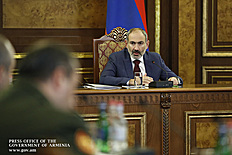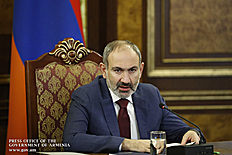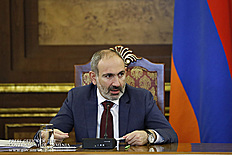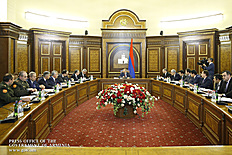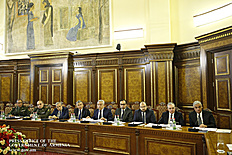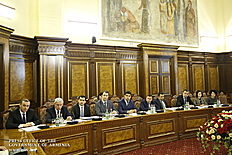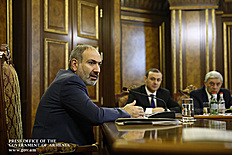Press releases
“The time has come to define the problem and establish a roadmap for strategy implementation” – Armenia’s draft national security strategy has been examined
more 4 photos
Prime Minister Nikol Pashinyan held a consultative meeting on the draft National Security Strategy of the Republic of Armenia.
Before proceeding to the meeting agenda, the Prime Minister delivered a speech in which he spoke about the results recorded in different spheres during the last 1.5 years and made some remarks. The Head of Government stated, in part:
“Dear Colleagues,
The first observation is that we need to devote more time to strategy and strategic work in the near future. Why now?
Since the first day of our government’s formation, we have been working very actively on strategic ideas. We can now say that we have completed our work with the logic of transition management, because you know that after the 2018 revolution, this step was inevitable and that we had to go through a transition period. Why do we find that I think this transition period is over? The first is related to the current state of our economy, the macroeconomic situation.
As you may know, the Republic of Armenia has recorded 7.5% economic growth in the first nine months. It is not an indicator of economic activity, but of economic growth, that is, growth of gross domestic product, which means that we have resolved our task at this stage of the economic revolution. Not only did we solve the problem of economic stabilization after the revolution, but we also laid the foundation for sustained economic growth.
The next big problem in this context is that we were able to solve the most pressing problems of our foreign policy in the last 1.5 years. In this context, I consider it very important to say that the Republic of Armenia and our Government have been able to position themselves in the Nagorno-Karabakh conflict settlement process in line with our current perceptions, our strategic interests and objectives.
The next remark is that we have succeeded, and this is already a reality, in ensuring democratic stability in the Republic of Armenia in the long term, and in asserting that this stability is based on the political facts acquired by the vote of confidence of the Armenian people, that is to say the ability to observe political facts in accordance with the perceptions of the Armenian people.
It is very important to note that we have effectively assumed responsibility for governing the Republic of Armenia during the constitutional transformation period of 2018, and we must affirm that the constitutional transformation from the semi-presidential system to the parliamentary system of government is a fact already.
It is very important to say that the processes that took place over the past 1.5 years in the economy, foreign policy, the negotiation process of the settlement of Karabakh, in terms of political life and democratic values and institutions, demonstrated the competitiveness of our strategic ideas or their compatibility with national interests. And now the time has come for our strategies to be underpinned by institutional documents on our future work.”
Referring to the need for Armenia’s development strategy, the Premier noted: “We have seen through the political processes of 2018 that a systemic crisis had matured gradually since independence, which was also a strategic crisis, and how was it expressed? This process was expressed in terms of circumstances and objective and subjective reasons - I wish to emphasize that there were both objective and subjective reasons - in the early days of the formation of our state, in the first period, and also in the future, this strategic work was not done to answer a simple question: And what kind of image should the Republic of Armenia have in the perception of the people in 2018-2020?
And so, the logic of the activities of the government and the local authorities had to be completely built on this strategic logic, that is to say that we had all planned our horizon of 10 years, 20 years, if possible longer, for that government agencies work with this logic. In other words, we would understand what goals we set, where we are going and how we would adjust our daily work based on how our activity has led us to the desired goals.
Therefore, we must already summarize our strategic perceptions at this stage and we, as a government, must also present to society the logic of 5, 10, 20, 30 years and, if possible, the country vision that should be the Republic of Armenia, according to our perceptions. This finding is, of course, good, but in the modern world and in the facts of today, we have a very important challenge to resolve: the modern world changes very quickly, and the means to reach the goal can to be seriously changed.
Even assuming that in 1991 we clearly stated what we would like to see the Republic of Armenia by 2020 in terms of the economic, political, demographic, security and security environment, we agree with the idea that it would be difficult to predict in 1991, for example, that such new technologies might be developed in the 2000s as would have a significant impact on the achievement of these objectives and even on our formulation toolbox.
As a result, we have two tasks: formulating our strategic perceptions and, at the same time, incorporating and creating tools to revise and refine these strategies to help them stay in touch with reality, so that our strategic documents do not lose touch with reality, do not lose their ability to live, their ability to be influenced by reality and to influence reality.
Therefore, we start our work on strategies in a larger format. Today we start with the national security strategy, which is one of the key strategies. Of course, as a result of our discussions, we must also determine our understanding of strategies, the subordinate system. We need to understand the top of our strategies and what is the main strategy or strategy to which other strategies need to be adapted, or is there such a problem?
I believe that today’s discussion should be based on this logic, and we must also agree that each strategy should be designed to have practical value and meaning. That is, they should not be adopted documents and put in the drawers, but they should be on our tables every day, depending on the logic of the day or priorities of the order of the day. They must be the essential tool for the synchronization of our local authorities, as well as our public life in general, so that our entire state system pursues the same objective and is guided by the same tools. That is our problem, which is a pretty difficult task, but this year-and-a-half work shows that we are able to solve this problem. The time has come to define, adopt and implement roadmaps for the implementation of strategic ideas.”
Issues related to Armenia’s national security strategy and the resulting sectoral strategies were discussed during the consultation. These included the process of developing strategic documents, the system of subordination of strategies, their interoperability, and monitoring issues.
The Prime Minister emphasized the importance of coordinating the ongoing work between ministries and relevant government agencies, overseeing the process of developing the strategy and presenting a benchmarking program for the strategy.
